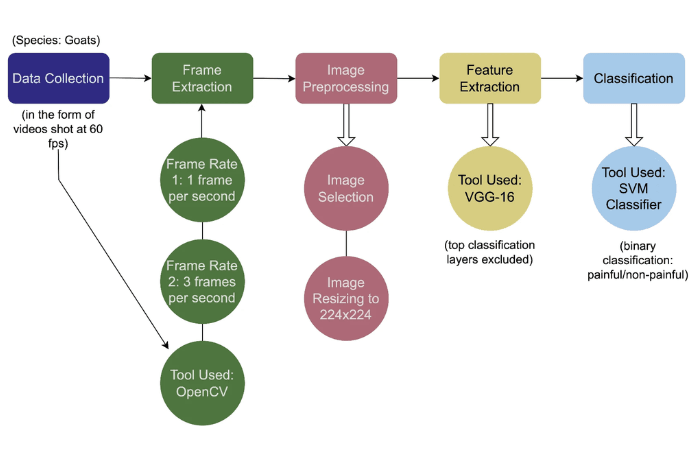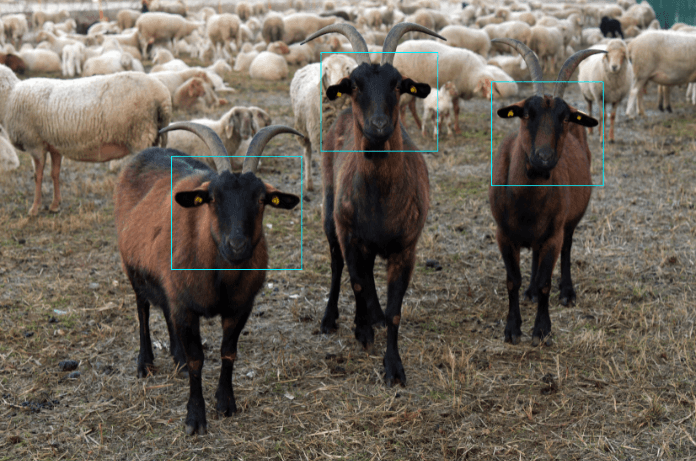A goat arrived at the veterinary clinic suffering from a bladder stone, visibly in pain and unable to engage in its usual activities, such as chewing its cud. While receiving treatment for her condition in small ruminants, the goat also contributed to groundbreaking research. The study presents fully automated AI flow for Pain Prediction in Domestic Goats using Machine Learning on Video Footage.
The Importance of Facial Expression in Animal Communication
Facial expressions are a vital part of how animals communicate, and specialized pain scales based on these expressions have been developed for various species. Automated pain recognition technology is becoming a promising alternative to manual observation, as research continues to build evidence across different animal types.
The Research : Automating Pain Prediction in Goats
In this research, machine learning (ML) techniques were applied, employing a pre-trained VGG-16 base and a Support Vector Machine (SVM) classifier to automate pain recognition. The study tested different frame extraction rates and validation methods to ensure comprehensive results in identifying pain in goats within hospital environments.
Expert Insights
The study included goats of different breed, age, sex, and varying medical conditions presented to the University of Florida’s Large Animal Hospital.
“If we solve the problem with animals, we can also solve the problem for children and other non-verbal patients,” noted Dr. Ludovica Chiavaccini, D.M.V., D.E.S., M.S., a clinical associate professor of anesthesiology at the University of Florida’s College of Veterinary Medicine.
Dr. Chiavaccini and her team conducted an experiment where they filmed goats in both pain and comfort, feeding this data into an AI model that learned to identify pain based solely on facial cues. The results, published on November 7 in Scientific Reports, were promising.
Key Findings of the Study on Domestic Goats
- Dataset Composition: The study utilized footage from 74 adult goats of various breeds, sexes, and ages. After excluding data that could interfere with results (e.g., sedated animals or those with secondary conditions), the final dataset featured 40 goats, comprising 2,253 images of non-painful goats and 3,154 images of painful goats at a 1 FPS extraction rate. This increased to 7,630 and 9,071 images respectively at a 3 FPS extraction rate.

- Model Accuracy: Depending on the testing parameters, the AI model achieved an accuracy range of 62% to 80% in recognizing pain through facial analysis.
- Consistency: The intra-rater correlation coefficient between individual scores on the UNESP-Botucatu Goat Acute Pain Scale (UGASP) was an impressive 0.96, showcasing high reliability between repeated assessments.
Current Challenges and Future Applications
Pain assessment in animals has always been challenging and highly subjective, often relying on a veterinarian’s experience. While standardized pain scales for various species exist, the quality varies significantly. This study highlighted the gaps in pain recognition tools for goats, prior to this, only a limited pain scale validated for male goats undergoing castration was available.
Automation in pain recognition, such as through AI-powered pain scales, promises to enhance animal care by providing more objective and efficient assessments. Although automated pain recognition is already being explored, it faces limitations, including the need for extensive human training in systems like the Facial Action Coding System (FACS), which is complex, costly, and not universally available for all species.
How Automation Advances “Pain Prediction”
Automated Pain Recognition (APR) is an evolving method that pairs image capture sensors with AI-driven pain algorithms. Two primary approaches to APR include:
- Landmark-Based or Key Points Analysis: This method focuses on detecting specific facial features linked to pain indicators.
- Convolutional Neural Networks (CNNs): These use deep learning to analyze facial expressions without relying on manually defined features.
Real-World Implications
Dr. Chiavaccini emphasized the broader importance of this technology, saying, “It’s not just an animal welfare issue. We also know animals that are in pain don’t gain weight and are less productive. Farmers are becoming more and more aware of the need to control acute and chronic pain in animals.”
AI-based pain scales could provide a valuable tool for veterinarians and farmers alike, improving both animal welfare and farm productivity.
While more research is needed to integrate AI-powered pain recognition into routine veterinary practices, this study represents a critical step toward more objective, consistent, and efficient animal pain assessment. With ongoing improvements and data collection, these models could become standard tools for managing pain not only in animals but potentially in non-verbal human patients as well.
Continued support and research in this field will pave the way for better animal care and even human healthcare. Investing in and expanding studies on automated pain recognition can bring a future where pain assessment becomes more accurate and humane for all non-verbal patients.

